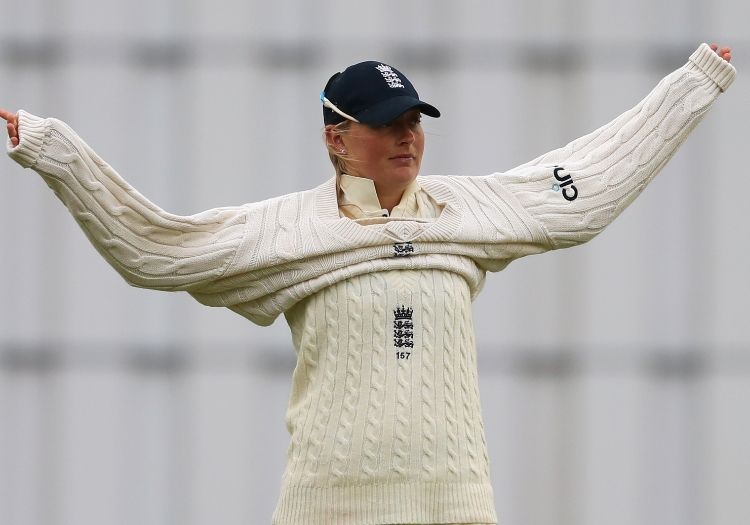NICK FRIEND AT BRISTOL: Sneh Rana departed the field, having saved a game for her country in a manner that limited-over cricket simply does not allow. A draw in the end, but a fine game and a fine advert


In all likelihood, you haven’t heard of Chamani Seneviratna – the youngest woman to make a Test century – a record she still holds in spite of Shafali Verma, who looked primed in both innings at Bristol only to fall short, if falling short is an appropriate means of description for one of the most compelling teenage debuts in recent memory. She has two more years to claim that record for herself, though, and you’d be a brave onlooker to bet against her.
Seneviratna’s was a curious career, typical of the time and certainly characteristic of the treatment that continues to be given to the longest format.
That was Sri Lanka’s first Test: a win against Pakistan in April 1998. But 23 summers on from her unanticipated intervention, it remains their last. She was a 19-year-old batting at No.9 as a seamer who, in a further 128 international appearances, only passed fifty once more.
There was never an opportunity to replicate the early promise of a debut hundred; her existence as an international cricketer spanning a further two decades and ending in the colours of United Arab Emirates, losing in her last game – perhaps fittingly – to Thailand in a T20 World Cup qualifier: a one-time trailblazer beaten by another.
Indian rearguard clinches draw for tourists on enthralling final day
As Thailand have shown, the women’s game has come a long way since Seneviratna, though the chronic shortage of Test opportunities is still a crying shame and a damning indictment on those who run the sport. This occasion, a rearguard draw earned from the jaws of defeat, was just the thirtieth since the turn of the century, meaning that a generation of the game’s best players have missed out on a career pinnacle. Chamari Atapattu, Sophie Devine and Deandra Dottin have amassed 613 caps between them, but not a single one against the red ball.
And so, to Verma: a child wonder so confident and assured at the crease that she applauded from the non-striker’s end whenever her partners defended solidly or drilled to the cover boundary, as if she was their coach and not a teenager who, when Mithali Raj made her international debut, had not yet been born. Her own defence was resolute when it needed to be, broken up only when she sensed an opportunity to score: shortly before her dismissal, when seemingly booked in for the day on 63, she became the first woman to hit three sixes in a Test and – somewhat surprisingly – the leading six-hitter in women’s Test history, whacking Sophie Ecclestone over her head for her third of the match.
On the previous afternoon, an array of cover drives off Katherine Brunt evoked a stream of unavoidable comparisons to Virender Sehwag – a take that was difficult to deny. That it came to an end when it did – caught outrageously in one hand by Brunt at long on – was a shame for the neutral, for whom watching Verma had become a veritable privilege in itself: the hardy few who have come through the Nevil Road gates over the last four days – and the crowd was, to be honest, a disappointment – will one day boast that they were there for the start of something special.
Quite how special she is able to become will be partially out of her hands. All being well – and it is important not to pin the weight of the world to the shoulders of a 17-year-old – this is just the start. India are due to play their second Test in seven years this winter against Australia, where the surfaces – and overnight Cricket Australia guaranteed a fresh pitch – will no doubt suit Verma’s game.

Sophie Ecclestone bowled 64 overs in the match
The ball is in the court of the BCCI, then, with a deeply watchable side at its disposal featuring all the tools required to compete at the top-end of the global game for a long time to come.
Sourav Ganguly has been defensive in his recent soundbites, claiming laughably that the actions of his governing body over the last 12 months are proof of commitment. The four-match T20 Challenge – a box-ticking exercise played out on tired pitches on Indian Premier League rest-days – would suggest otherwise, as would the 364-day gap between the T20 World Cup final last March and a heavy defeat against South Africa earlier this year and the recent revelations uncovered by the Daily Telegraph.
Here, in spite of those hindrances, the performances of India’s youthful band were superb: for all the talk of Verma, Deepti Sharma is a 23-year-old allrounder of significant talent and a maturity beyond the years of a left-hander on Test debut. In their first innings, several of India’s players seemed stuck between the notion of batting time and batting simply to survive – hardly a surprise for a side with five Test debutantes.
At one stage on Friday, Sharma had faced 44 deliveries for just a single, but she wore down England’s spirit and brought up her maiden half century shortly before lunch, having earlier been not out for the tourists at the end of their first innings.
That she ended her 168-ball vigil one ball prior to the interval with the ugliest mow imaginable – a real homage to Shannon Gabriel – was a rare lapse in concentration out of kilter with all that had come before. Had she connected fully – rather than chopping onto her stumps – Bristol would have been asking for its ball back. As it was, it threatened to mark the end for India’s resistance: Raj, whose entire display was a distant shadow of her best, fell cheaply for the second time in the match, while Harmanpreet Kaur succumbed twice to Ecclestone, her former Kia Super League teammate.
Katherine Brunt! 👀#ENGvIND pic.twitter.com/U3AmvPwlct
— The Cricketer (@TheCricketerMag) June 19, 2021
Thereafter, an England victory seemed an inevitability – a first on home soil since 2005 in this format – and, overall, a fine advert for more Tests more often. But gradually, that sense of certainty evaporated, with Sneh Rana, a lower-profile debutante of little previous repute in the international arena, taking on the mantle of defier-in-chief. She was exceptional, coming to the crease when India were just 27 runs ahead and England increasingly dominant, but departing only when each umpire had pulled the stumps from their holes and a great escape was complete.
For all the discussion of the talented youngsters on either side – Sophia Dunkley’s first innings half century now felt as though it belonged in a far-away past – there was something incredibly gratifying about watching Rana, a 27-year-old in her first international appearance for five years, having the final word. In a sense, it spoke to the opportunities afforded by England’s new regional structure, which should nudge the door ajar for players of Rana’s age, who might once have felt their ship had sailed.
Honed on the domestic circuit of India, the off-spinning allrounder, who had earlier taken four wickets in England’s first innings, cut savagely and drove when the home bowlers overpitched, knackering their hosts whose decision to enforce the follow-on meant they spent 202.2 overs in the field consecutively across two innings, not that they had much choice given a changeable weather forecast. That’s a lot of overs, though, even before considering this was England’s first taste of multi-innings cricket for two years – and India’s first since 2014.
On a tactical level, Heather Knight could look back with hindsight on a team selection that was one frontline spinner short: Ecclestone bowled 64 overs, her arm only kept attached to the rest of her body by a repeatable action and an unerring desire to claim a maiden five-wicket haul at international level – one of few feats still eluding a 22-year-old whose talent deserves so much more than three Tests in her five years so far as an international cricketer.

Katherine Brunt took a remarkable catch to dismiss Shafali Verma
Perhaps, however, the game’s crowning glory came much earlier on the fourth day, with India still only for the loss of Smriti Mandhana. Verma, 17, had just deposited Ecclestone over her head for six, having gone to a second fifty of the match shortly before the close on Friday. At the other end was Sharma, 23, seemingly immovable and mightily impressive.
Hovering ten yards in from the boundary edge was Brunt, 35, whose battle with the teenage opener had been brewing throughout. Indeed, when she made her Test debut in 2004, Verma was seven months old. Their duel had been fascinating: some choice language was picked up on the stump microphone and it felt as though her wicket had become Brunt’s ultimate mission.
When it came, it was spectacular: an outrageous piece of cricket by anyone’s standards, let alone those of a fast bowler 17 years and 226 games into her international career.
Verma miscued and Brunt, having initially been slow to pick up the stroke amid a backdrop of multistorey apartments, sprung to her left and launched herself at the ball as it flew past her. It stuck in her weaker hand, before she returned to her feet and began her celebrations. You got the sense that she might even have surprised herself.
It was quite a moment within a Test that had plenty to choose from. A moment between two of the game’s greats – one of its present and future, of its past and present. A moment that screamed out for more weeks like this.
When Sneh Rana departed the field, she had saved a game for her country in a manner that limited-over cricket simply does not allow. A draw in the end, but a fine game and a fine advert. More of this, please.